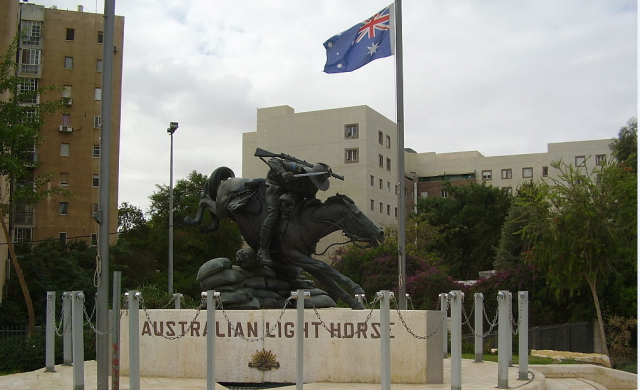
In Australia’s memory of the Great War, the Sinai–Palestine Campaign gets comparatively little thought after Gallipoli and the Western Front. The exception is the Battle of Beersheba, fought on 31 October 1917, which has lodged in the collective memory in a way that no other Australian action in Palestine has. The battle’s comparative fame probably owes much to the fact that it has been twice dramatised in feature films, first in the 1940s in Forty Thousand Horsemen and then again in the 1980s in the The Lighthorsemen. Both films use the dramatic charge by light horse as their centrepiece, and that part of the battle has seemingly become its defining moment. Of course, the battle involved more than just the charge, and as it joins the Great War centenary cavalcade it seems a good moment to give it a more thoughtful appreciation.
At the greatest remove it is useful to remember that this battle was just one episode in an epochal worldwide war that dramatically reshaped the international order. That contest was abundantly apparent in the Middle East, where almost all the great powers were pursuing their ambitions. Indeed, what had started as a defence of the Suez Canal and the ‘Egypt base’ had, by 1917, evolved into a British and French attempt to expand their empires and influence at the expense of their Ottoman opponents, who were in turn trying to expand theirs in the Caucasus.
Bearing this in mind, Britain’s Egyptian Expeditionary Force (EEF) had, after defeating an Ottoman advance at Romani in August 1916, advanced across the northern Sinai before making two failed attempts to capture Gaza in March and April 1917. With the campaign stalled in southern Palestine, the War Office recalled the EEF’s lacklustre commander and sent out the more dynamic General Sir Edmund Allenby. With him came extra resources, and Allenby recrafted the EEF from a largely ad hoc colonial column into a modern army. His revitalised force was expected to restart the advance and urged to secure Jerusalem.
Hence Allenby opted to attack in southern Palestine by striking at his enemy’s southernmost flank at Beersheba. The water sources there would then facilitate a drive northward, which Allenby hoped would get behind Gaza and encircle the Ottoman garrison. Rather than an end in itself, seizing Beersheba was the first part of a great offensive to drive the enemy out of southern Palestine.
To that end, in the early morning of 31 October the EEF’s XX Corps commenced an artillery barrage and then infantry attack on the defences southwest of the town. Virtually ignored in Australia, this assault was entirely successful, but contested enough that a Victoria Cross was won and the attacking infantry suffered almost 1,200 casualties. In the meantime, the mounted troops of the Desert Mounted Corps, commanded by Australia’s Lieutenant-General Sir Harry Chauvel, had made a long approach march during the night to get into position southeast of the town. Here the first priority was to cut the Beersheba–Hebron road at Tel el Sakati, and seize a large hill known as Tel el Saba. This steep-sided hill had a well-supported Ottoman garrison in terraced trenches that dominated the approach to the town. Taking it was vital.
The 2nd Light Horse Brigade cut the road but had to endure heavy enemy fire for most of the rest of the day. The New Zealand Mounted Rifles Brigade was sent against Tel el Saba, but using mounted troops like infantry against prepared positions was tricky (despite what is often written and said, the light horse were not mounted infantry, but fulfilled a cavalry role). Lacking the man- or firepower to pound the entrenched enemy, they had to work their way forward until they could launch a final assault. That took hours and as the day marched on Chauvel sent Australian light horse to assist. The hill fell to the New Zealanders at around 3 pm. The route to town was now open but it had to be taken that day and Chauvel agreed to a suggested mounted attack. The 4th Light Horse Brigade was closest and its British divisional commander, Major-General Henry Hodgson, had issued orders several days earlier encouraging mounted attacks in the right circumstances. Two regiments lined up to the southeast of town and supported by artillery galloped in the fading light over the remaining Ottoman defences to capture the town.
It was remarkable feat of arms, but by no means the last cavalry charge, as is often claimed. There were numerous mounted attacks by Australian, British and Indian troops in the remainder of this campaign alone. Nor was Beersheba the ‘turning point’ of the campaign. The Ottomans had been on the back foot since Romani a year earlier and there was still another year’s worth of hard campaigning ahead.

